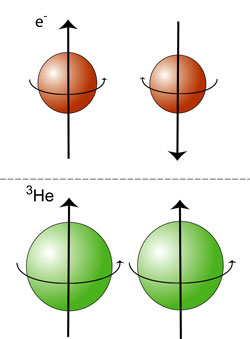Nobel Focus: Helium Impersonates a Superconductor

Part of this year’s physics Nobel prize went to Anthony Leggett of the University of Illinois at Urbana-Champaign for his work on superfluid helium. A superfluid flows without any viscosity or resistance and has other exceptional properties. In 1965 Leggett formulated a theory of the superfluid phase in helium-3–the rare isotope of helium–in the Physical Review. Seven years later, just weeks after the discovery of the superfluid, he extended his analysis in a PRL paper and precisely identified the state that was seen in the new data. Leggett’s theory has been borrowed in many areas of physics, including models of phase transitions in the very early universe.
In 1957 the Bardeen-Cooper-Schrieffer (BCS) theory explained superconductivity, in which a superfluid of electrons allows electricity to flow through a solid without resistance. In that model, pairs of electrons with opposite spin form so-called Cooper pairs with zero total spin. Having an integer value of spin allows all of these pairs to inhabit the same quantum ground state–a so-called condensed phase–when the temperature is low enough, which leads to superconductivity.
Several physicists quickly realized that BCS theory should also apply to helium-3, suggesting the existence of a superfluid state at ultralow temperatures. Superfluidity had been found in helium-4 in 1938 at about 2 degrees kelvin, but because helium-4 has integer spin, it can form a condensed phase without the need for a pairing mechanism.
Leggett’s comprehensive 1965 paper analyzed the consequences of helium-3 atoms forming pairs and showed that a superfluid state could have significantly different magnetic properties than the normal state. In 1972 Douglas Osheroff, now at Stanford University in California, and two colleagues measured unusual magnetic properties in helium-3 below 2.5 millikelvin. The team believed they had discovered the superfluid state, and after seeing an early write-up of the work–which won the 1996 Nobel prize in physics–Leggett agreed and published his PRL paper laying out the atomic-scale explanation.
Leggett and others expected the pairs would have a spin value of one, rather than zero, as in a superconductor. In his 1972 paper he worked out the effects of spin-one pairing. He found new states where all of the pairs’ spins line up spontaneously, like a row of bar magnets. In such an arrangement, normally weak magnetic effects would become much stronger. His most surprising finding was a state that involves the two types of angular momentum in a spin-one pair: orbital angular momentum associated with the two atoms orbiting about one another, and spin, which is intrinsic to each atom. Imagine two arrows–one for each type of angular momentum–connected to each atom pair. In Leggett’s new phase, the angle between the two arrows is the same in every pair, even though each pair’s overall orientation is random.
Helium-3 “is a very good BCS system,” says Osheroff. Leggett “understood that well [and] went through the ramifications very carefully.” Further investigations during the 1970s revealed the phases that Leggett described in his 1972 paper. “Tony predicted a lot of things that we were astounded to find were correct,” Osheroff adds. ”I’m elated that he got the Nobel.”
–David Lindley
David Lindley is a freelance science writer, now retired. His most recent book is The Dream Universe: How Fundamental Physics Lost Its Way (Penguin Random House, 2020).


